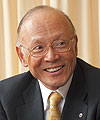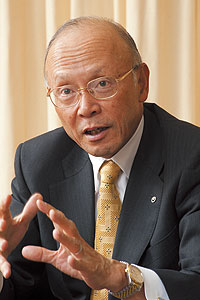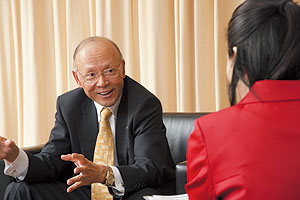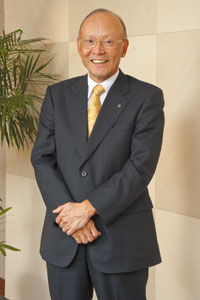 |
|
|
|
|
|
View from the Top Vol. 9, No. 1, pp. 1–5, Jan. 2011. https://doi.org/10.53829/ntr201101tp1  No Longer Just a Japanese Telecom Operator— Becoming a Global ICT Service CompanyOverviewFor our opening interview of 2011, we had the pleasure of talking again with Noritaka Uji, NTT Representative Director and Senior Executive Vice President, who has been a great promoter of service creation in the NTT Group. We asked him about NTT’s global expansion, which has already begun, and this year’s strategy for the NTT Group, which supports the development of a ubiquitous broadband society. Coming to fruition in 2011: the NTT Group Medium-term Management Strategy—Last year, with the strong yen, there was little good news for Japan. What will this year be like? Please tell us your thoughts on this, beginning with your objectives for this year. Well, last year was certainly very difficult, what with sluggish exports due to the strong yen and the slow growth of domestic demand. However, lackluster economic conditions do not mean that there can be no healthy and active areas in the economy. This year can be made into a vibrant one through great ideas and techniques. For us, this means information and communications technology, or ICT. I think that there are many areas where NTT, as a leading ICT company, can be active in helping to expand the economy and solve social problems. This year, I would like to accelerate our efforts in service creation, which we have been promoting for the last few years, and put even more energy into true global expansion. Today, all kinds of services are appearing as part of the worldwide trends of service convergence and paradigm shift. One example is the convergence of broadcasting and communications as in video delivery over communication circuits and One Seg (one segment) television broadcasting on mobile phones. Furthermore, as your readers probably know, a paradigm shift from owning to using is now taking place with the coming of cloud computing. New technologies and services that drive such service convergence and paradigm shifts are born through various types of collaboration. Inside Japan, there is of course collaboration among different industries, but I would also like to take up the challenge of achieving great developments in technologies, services, and even the economy through international collaboration that can take on various forms.
Further expansion of the broadband network—This year looks to be a very dynamic one. Could you give us some specific examples of this year’s activities? So far, we have been working on expanding the reach of the broadband network through fixed systems like the Next Generation Network (NGN) and fiber to the home (FTTH) and mobile systems like 3G (third generation) and Long Term Evolution (LTE). Japan’s broadband network has become the world’s fastest and cheapest by applying optical and wireless technologies cultivated over many years and promoting cost-reduction technologies. In Japan, optical broadband covers about 90% of the country, and the NGN coverage area is scheduled to encompass most of the existing optical area by March 2011. In addition, the Xi (pronounced crossy) mobile high-speed broadband service based on LTE was launched in Japan in December of last year. I take great pride in the ability of our broadband network to satisfy our customers though its high-speed, large-capacity, high-reliability, and low-cost features. But we cannot stop here. It is also important that we ask ourselves: “What kind of services and what kind of value can we provide our customers by exploiting this infrastructure?” To this end, we are actively promoting the provision of services using both the fixed and mobile broadband networks. Toward new lifestyles through full-scale development of video, Home ICT, and cloud services and promotion of fixed-mobile convergence—What services are you contemplating at present? I’m thinking of services that make maximum use of broadband capabilities. In particular, I would like to take the video, Home ICT, and cloud services that we have already been promoting to even higher levels while also planting seeds for new services. Hikari TV, a video-delivery service using an optical IP (Internet protocol) network, already has more than 1.2 million users, and this number is expected to climb to about 1.4 million by the end of fiscal year 2010. This service gives users access to retransmissions of digital terrestrial broadcasts, multichannel broadcasts, and video on demand. And in 2010, we launched three-dimensional (3D) video delivery, a remote scheduling service using mobile terminals, and IP retransmissions of broadcast satellite programs. In 2011, there are also plans to begin trials centered on NTT Laboratories for a full high-definition (HD), 3D video delivery service as part of our ongoing efforts to provide more convenient and enjoyable services. Furthermore, on the business scene, we announced Hikari Conference last year as a common brand for high-quality video communications. One product we launched under this brand is RiscaVision, a full-HD-quality videoconferencing system using the NGN. Here, by using high-quality networks and the latest video coding techniques, we are achieving a level of quality that makes users feel as if they are really sharing the same space. From here on, I would like to pursue the realization of high-quality multipoint connections that bring together even more people and locations, and I would like to make such advanced services available to general users as well. For example, I think it would be very useful to expand connections between people and between people and their family and home regions, such as by connecting grandparents and grandchildren living in homes far away from each other. As for Home ICT, we have been forming alliances and conducting joint experiments with many companies since December 2009, especially major home-electronics and office-equipment makers. With basic technology-verification experiments completed, we began field trials in November 2010. Genuine services will finally commence from spring 2011. The number of subscribers to various Home ICT services that are already being provided is increasing steadily. These include support for configuring personal computers and network devices and a remote support service for responding to user problems. Looking forward, we can see Home ICT becoming a home control center that serves to improve the quality of life and help solve diverse social problems in relation to home security, video sharing, medical treatment and healthcare, education, the environment, and other areas. This Home ICT technology can also be expanded as office ICT to the large number of medium-sized and small companies in the economy, and I would like to push this forward. Then there’s the cloud! I would also like to focus our attention on cloud computing. As you know, the NTT Group has been developing platforms and networks for achieving clouds as well as applications to run on those platforms in collaboration with partners. At NTT Laboratories, important large-scale distributed processing platforms and operations and management technologies are now being developed toward expansion of cloud computing with an emphasis on keywords like open, secure, large-scale, distributed, and eco. In this regard, a research and development (R&D) cloud that includes these developments is scheduled to be launched in 2011. At first, this cloud will be used for researching and developing a variety of services and technologies. In time, however, I would like to see it linked with business enterprises and outside research institutions to further expand the use of cloud computing. I would also like to apply the know-how and experience that we gain here to corporate clouds and government, medical, healthcare, and educational applications to construct a safe and secure social-infrastructure cloud.
—It appears that life is becoming more manageable and enjoyable and that lifestyles are changing because of these services. That’s right. And by furthering the development of video, Home ICT, and cloud computing, we will soon be entering an era where it will be commonplace for users to seamlessly access their daily living and working environments without regard to place or type of terminal. The use of tablet personal computers (PCs) to read electronic books and perform other tasks is already spreading, but it is also becoming possible to partake in e-learning, to view movies or sports programs, or to receive recommended services using high-quality video from PCs, tablet PCs, or smartphones connected to school or home networks. This seamless access should reduce the stress that users feel when making a new connection with a different terminal. In 2011, fixed-mobile convergence (a service format converging mobile communications and fixed-line communications) that includes the broadband network, upper-layer services, and various sorts of terminals will become all the more important. Accelerating R&D for enhanced service creation—These services are already quite amazing, but are they still evolving? Service creation is endless! This is because simply being able to provide a service is not the same as making it easy to use and providing it at a reasonable price. The mobile phone, for example, has evolved from a car phone to a shoulder phone and then a handset and has even become a fashionable product. All sorts of functions are now appearing on mobile phones such as concierge services and mobile wallet (Osaifu-Keitai), and nowadays, the mobile phone is simply becoming one’s mobile or smartphone, which is coming to be used in all facets of everyday life. Mobile phone technology is evolving much faster than I originally imagined. From a global perspective, it is amazing how the number of mobile subscribers has surpassed fixed-line users in Japan, how fast and inexpensive broadband connections have become, how computer performance and memory capacity have significantly increased, and how large volumes of data can now be uploaded to servers. Even though I understand how all this is technically possible, the speed at which it has been achieved is truly remarkable. —As a service provider, it would seem that NTT is feeling pressure to provide services at breakneck speeds. Yes, that’s right. I’m always telling researchers and developers that “Speed is of the essence!” and that “Today’s R&D pace is not good enough—we have to move faster!” If it were only NTT providing services, perhaps the current pace would be sufficient, but this is a market with all kinds of global players in which many technical innovations are being made. Here, it’s the cloud that is attracting lots of attention. Participants in cloud services include computer and network-device makers, network-related start-up companies, the software industry, and even telecommunications operators like NTT, so the mechanism of competition is changing radically. It is exactly for this reason that technical innovation and the development of competitive products are being forced to move faster. We must respond to this sort of competition too. NTT began as a Japanese telecommunications operator, but it wants to become an enterprise that provides ICT technology and services on a global basis. I see NTT as a company that, while expert at developing technology, also knows how to use that technology and to provide it in the form of actual services. NTT R&D includes about 6000 researchers throughout the NTT Group. It has a world-renowned reputation and is the source of NTT’s competitive power and growth. Of the research projects that are now being undertaken and technologies that are now being provided, perhaps some of them are not progressing very well, while others are perhaps ahead of their time. Needless to say, we must make an effort to provide products more appropriate for customers and the times by, for example, improving cost performance and ease of use. There are still many things that we can do to provide customers with good services while competing globally. The level of quality demanded by Japanese consumers, by the way, is very high in a good sense (laughs). So a good scenario, I think, is to make Japanese technology grow and to then take this technology overseas with an eye to global expansion. Becoming a global ICT service company—In this regard, I’ve heard that NTT provided technology for the World Cup held in South Africa. Yes. We provided video transmission equipment for the 2010 FIFA World Cup in South Africa. This equipment was used by 20 broadcasting stations around the world to deliver high-quality video to 60 countries. It is an example of the service convergence between communications and broadcasting that I talked about earlier. More recently, our technology has been used at the rescue site for the Chilean miners trapped by a cave-in. Do you remember how a videophone was used to check on conditions down below? That videophone used NTT technology. Speaking of Chile and mining, NTT teamed up with CODELCO, a Chilean state-owned mining company, in 2006 to establish a joint business venture called Micomo to expand NTT R&D products to the mining industry, which is outside NTT’s traditional line of work. Micomo was the company that passed an optical fiber through a hole opened up from the surface at the rescue site and installed a videophone. Since cave-ins and other types of accidents have always been a possibility in mines, we established Micomo thinking that safety management and means of communication are absolute necessities underground. I am extremely pleased that NTT video-communication technology proved to be useful at the rescue site. —I can see that NTT technology is establishing a global presence. Please tell us about NTT’s global strategy for the future. Talking about the global situation, merger and acquisition (M&A) activities with overseas firms have become a trend in Japan as a result of the strong yen. NTT is no exception to this trend—the reality is that the Japanese market is rapidly shrinking, and in the end, global expansion is essential to the company’s growth. The worldwide market is still growing, and it’s simply too good an opportunity to pass up. NTT Group’s overseas sales target for fiscal year 2012 is $10 billion, which shows how the currency unit for this forecast has been changed from yen to dollars. This is certainly one example of how NTT is not just a Japanese company but one that is expanding globally. The fact is, NTT is actively promoting M&A. Dimension Data, which we purchased in 2010, is a South African company that became a group company under the NTT holding company last autumn. We are expanding our business throughout the world including South America, Africa, the Middle and Near East, and Australia, which I think is opening up new, fresh markets for NTT. In addition, Keane, Inc., which was purchased by NTT DATA, is a leading player in the systems integration business in the USA, and we think that it should provide the NTT Group with a solid foothold in the American market. Although it is a Japanese communications company, NTT is expanding its business regions and content with an eye to becoming a global ICT solutions company and service provider. With these big changes, NTT will finally make a genuine move into the outside world. It is visionary and pioneering for a non-manufacturing telecommunications company like NTT to expand globally other than in the network business and to broaden its business line. The NTT Group boasts multifaceted group power that includes upper-layer services, solutions, construction and power, and R&D in addition to fixed and mobile communications businesses, and I think that these comprehensive abilities should be demonstrated. By the way, around the time that Nippon Telegraph and Telephone Public Corporation became NTT, I read with great interest a book entitled “In Search of Excellence”. The word excellence in this title referred to a hands-on customer-first policy that companies should adopt. I want NTT to be an excellent company and its individual units to be excellent as well. It should be a company that enjoys a difficult challenge, whose customers are highly satisfied, and that is well respected for its achievements. This is a year of great challenges that will stimulate NTT Laboratories and the entire NTT Group. Just watch us now!
Interviewee profileCareer highlightsNoritaka Uji joined Nippon Telegraph and Telephone Public Corporation (now NTT) in 1973. He handled tasks related to NTT privatization and startup business development. In 1988, he moved to NTT DATA, where he was initially in charge of planning and developing information systems for private enterprises. He then served in various managerial roles including Director of the Next-Generation Information Services Sector, Senior Vice President and Director of Business Planning, and Senior Vice President and Director of Enterprise-related Sectors. Building on these experiences, he assumed the post of Senior Executive Vice President in 2005. He began serving in his present position in 2007. |
|










